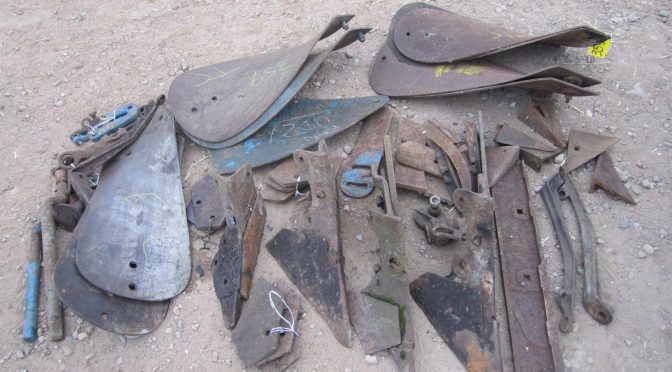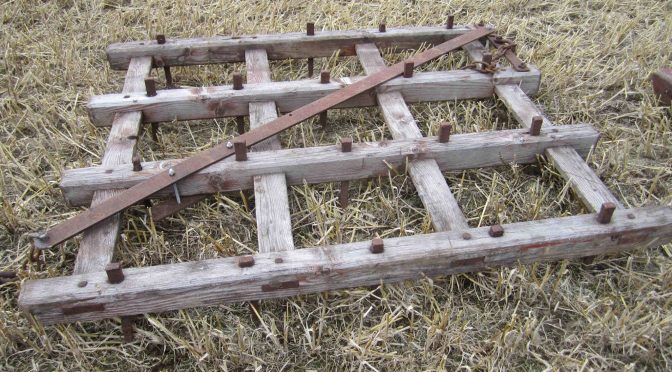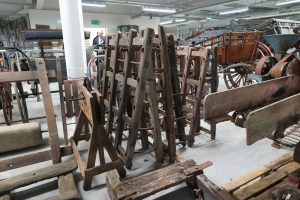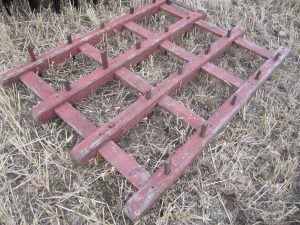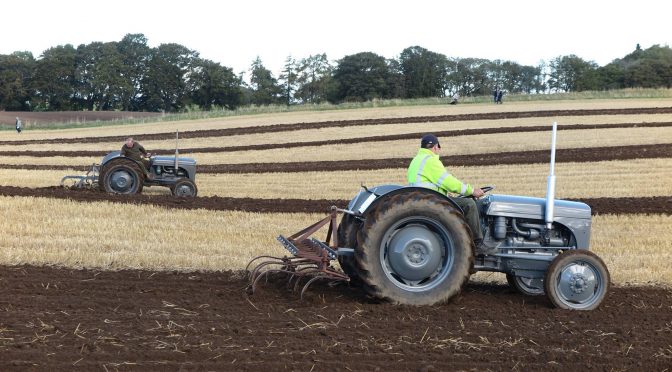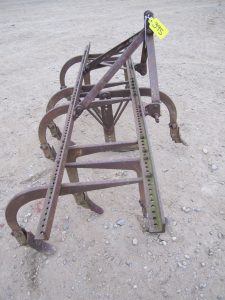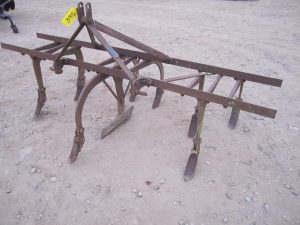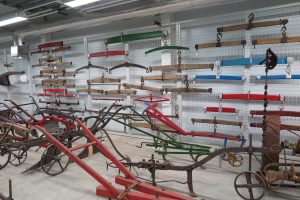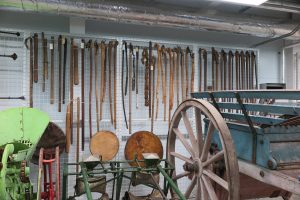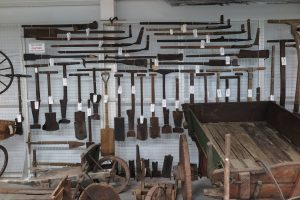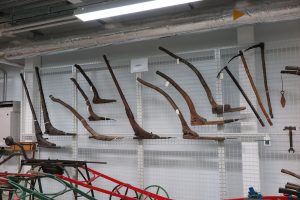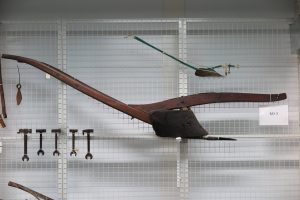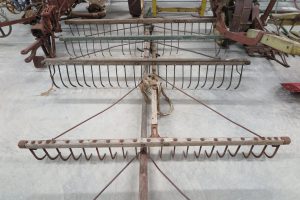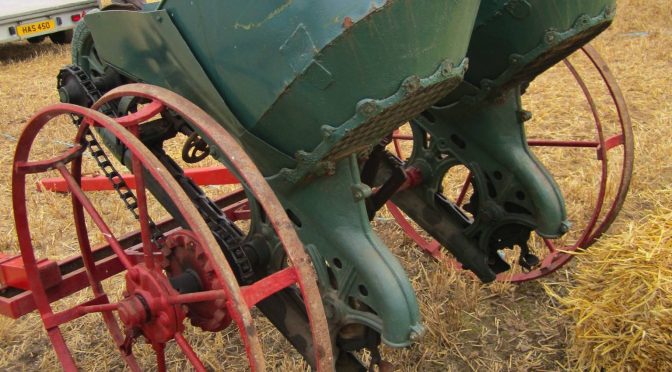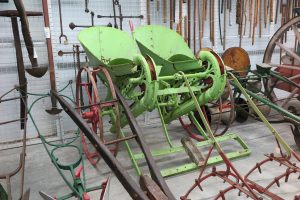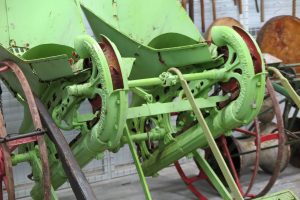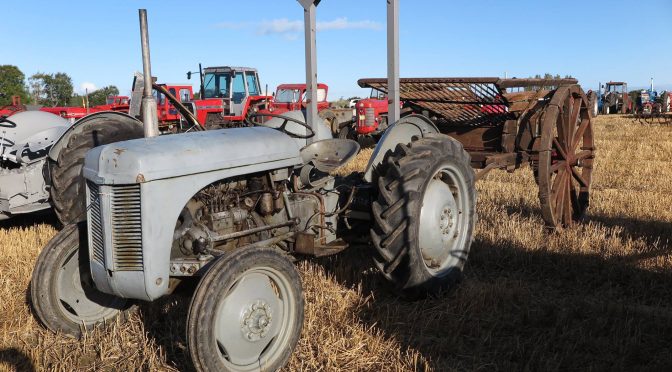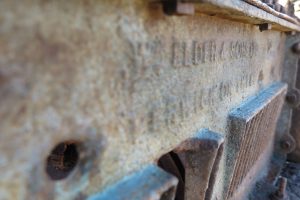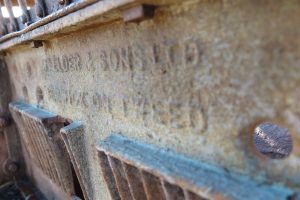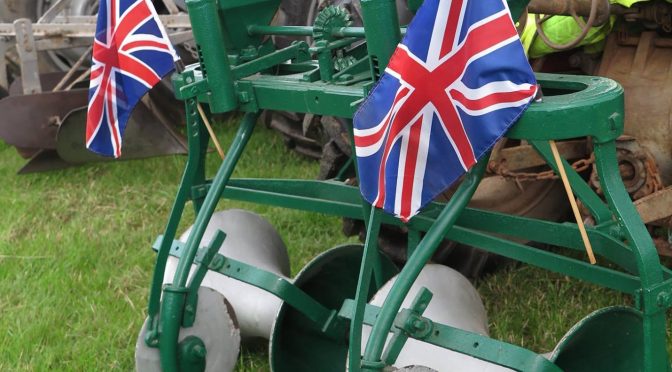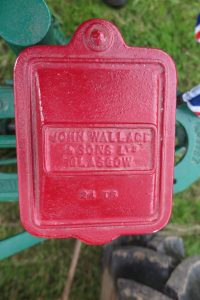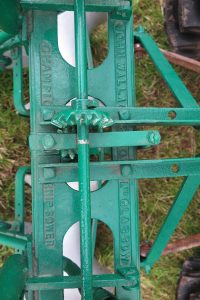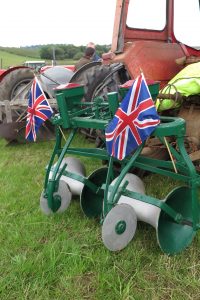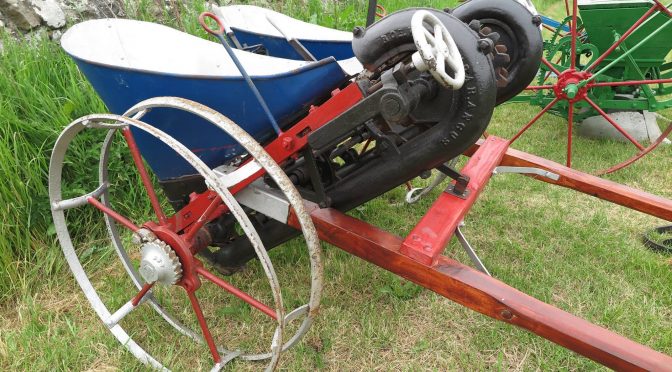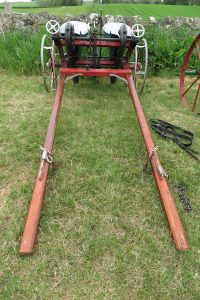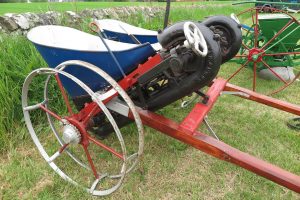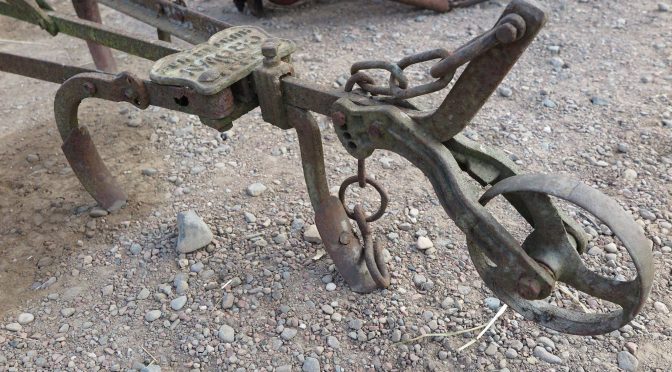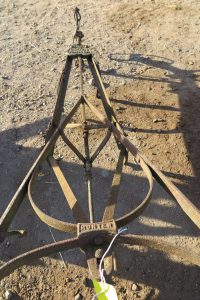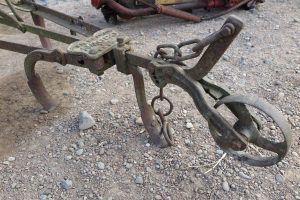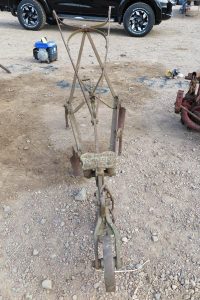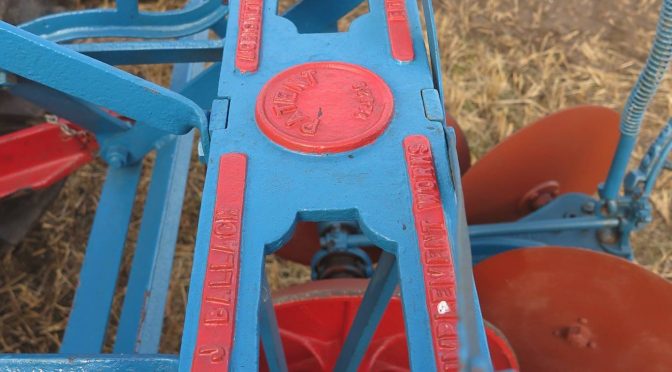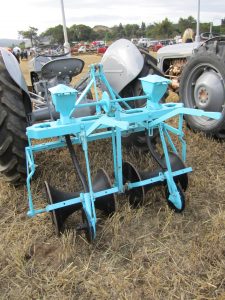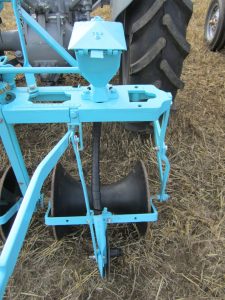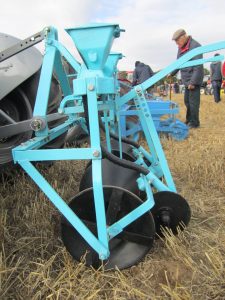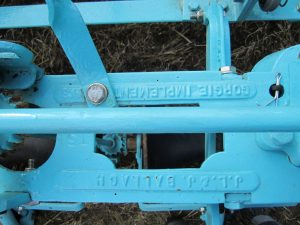The Board of Agriculture and Internal Improvement undertook an important survey of agriculture and rural improvement in Britain from 1793 to 1817. Each survey generally focused on a county or a small number of counties.
The accounts contained detailed accounts of the implements and machines used in each county, together with the changes that were being made to them.
The account for Kincardineshire, written by James Robertson, provides insights into the character and state of implements used in that county.
It is worth quoting at length:
“Implements and machinery have no where, all Britain, met with more effective implements of husbandry, than in this county; constructed on principles of great simplicity, they are at the same time, both handsome and durable.
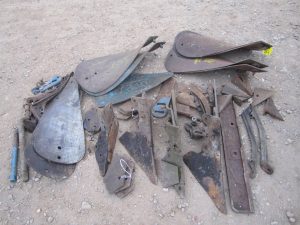 Ploughs
Ploughs
Upon the coast side, chiefly in the vicinity of Stonehaven, or rather of Ury, which set the example, there are still some wheeled ploughs to be seen. But these, though doubtless a great improvement at the time when Mr Barclay introduced them, are too complex to become general,or even to retain the ground they once had. I believe there are few of this kind now renewed, their place being supplied by the improved plough of Small, which is fully as effective in its operation, and less intricately constructed. Small’s plough has itself undergone an alteration, in this county, more adapted to the nature of the soil, which is remarkably stony. The curve of the cast-iron mould-board is made convex at the back part so as to push the stones more readily aside than if the original concavity of that part had been retained. A plough of this kind, with its gear for two horses costs about £4 or 4 Guineas. Nineteen ploughs in twenty are of this construction.
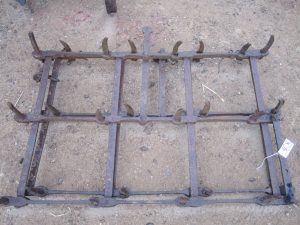 Harrows
Harrows
Harrows are now beginning to be constructed of five Bills with five iron tyne in each. A pair is generally connected with an overlying bar, moveable at pleasure, so as to set them nearer or farther from each other, as may be required, and which prevents them also from interfering with or riding upon one another. A pair drawn by two horses, under the direction of one man, covers vet correctly nine feet in breadth; or, as in common practice, two pair take sin an eighteen feet broad ridge at a time. A pair of harrows, with all their mounting, costs from one point ten shillings to two guineas.
Rollers
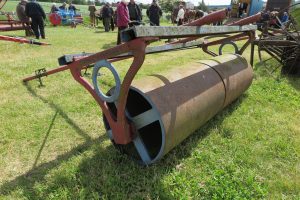 These are universally used; but the greater number are still of wood. Several indeed are of stone. But the stone of this county is not much adapted to the purpose; being either too soft, ad in the case with the red free stone, or too hard to bring into shape, as happens with the pudding stone and the granite. Rollers, with all their mounting, will cost from two to four guineas. They are commonly about six feet long, and from 15 to 18 inches in diameter.
These are universally used; but the greater number are still of wood. Several indeed are of stone. But the stone of this county is not much adapted to the purpose; being either too soft, ad in the case with the red free stone, or too hard to bring into shape, as happens with the pudding stone and the granite. Rollers, with all their mounting, will cost from two to four guineas. They are commonly about six feet long, and from 15 to 18 inches in diameter.
The drag-harrow or brake
This implement is not very generally employed. In a great part of the soil of this county, free and in adhesive, it is not wanted. But in some places, where the soil is deep, and obdurate, it is required, and is there to be seen very strong and powerful, drawn by four, and sometimes by six horses. The price may be stated at from fifty shillings to five pounds.
There are many various kinds of drilling and hoeing machines, in which it is always found, that the less complex they are in construction, the more effective they are in practice.
One of the most ingenious of these is the turnip sowing machine, drawn by one horse, and which is as simple and uncompelled in the construction as we can well suppose such a machine to be, that sows not only two drills at a time, but had a set of rollers that go before and another that follow the seed, and which deposits it also with the utmost accuracy at a depth in the very centre of the drill. It now costs six pounds.
The sowing sheet
This is literally a bed sheet applied to the purpose, and is in very general use. In some places they employ for sowing, a basket covered with leather, and slung about the neck with a leathern strap. This is a most incommodious implement, introduced as an English fashion, and kept up from prejudice. The handsome and light sowing sheet of the Lothians, constructed of less than a yard of linen, and so slender that it may be put in the vest-pocket, has been but lately introduced, and has not yet spread far.
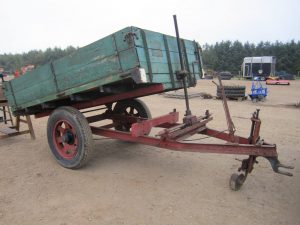 Carts
Carts
A great improvement has lately been made upon the art. Instead of the side boards being fastened to the standards with nails, which were for ever shaking loose, these are now attached with small screw bolts, which give a steadiness to the whole fabric that could never have been attained with nails; while the same bolts may outlast many sets of carts, and this become in the end even cheaper than nails. A cart, with its wheels, iron axle, tops, and other gear, costs from twelve to sixteen pounds; and the harness for two horses, seldom less than five pounds more.
In places where the roads are completely made, the single horse cart is beginning to come into se. The large four, six, or wight horse waggon may still be seen at Ury, but was never employed any where else. Indeed that mode of carriage is by no means adapted to the uphill and downhill roads of Scotland; nor perhaps if economy be considered, it is adapted to any country whatever.
All machinery in this county is carefully painted; sometimes brown, sometimes green, but the most common colour is alight blue, particularly for ploughs and the bodies of carts, but the wheels are almost universally painted red.
Among the lesser implements may be mentioned the tramp-pick, here in very general use, but which, I have not observed in the counties farther to the south. This is a kind of lever, of iron, about four feet long, and an inch square in thickness, tapering way at the lower end, and having a small degree of curvature there, similar to the prong of a dung fork. It is fitted with afoot step, about eighteen inches from th lower end, on which the workman presses with his foot when he is pushing it into the ground, or into the hard gravel. At the top oit has a handle of wood like the handle of an augur or wimble. The workman, after having forced the under end of the instrument into the earth with is foot, applies his hands to this handle and bends it backwards with all his force, so as to detach a considerable mass of the earth or gravel, which he is wishing to raise up. It is used chiefly in working the bottom of ditches, where the obdurate subsoil composed of a congeries of hard, compacted gravel, would without this previous loosening by the tramp-pick, be altogether impenetrable by the spade.
Threshing mills
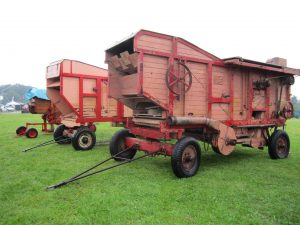 The invention of the mode of threshing corn by machinery is of recent date; at least the successful application of it to business is confined to modern times. The first threshing mill was erected in Mid Lothian was by the late Mr Francis Trells, an Hungarian, about the year 1785 or 1786. Before that time there ere not above two or three of them in Scotland, where they were first brought into use, and where they are more generally employed still, than in South Britain.
The invention of the mode of threshing corn by machinery is of recent date; at least the successful application of it to business is confined to modern times. The first threshing mill was erected in Mid Lothian was by the late Mr Francis Trells, an Hungarian, about the year 1785 or 1786. Before that time there ere not above two or three of them in Scotland, where they were first brought into use, and where they are more generally employed still, than in South Britain.
At what time threshing mills were introduced into Kincardineshire, I have not been able to find out precisely. But it was not long till they were erected in this county after they were invented. At farthest this took place about the year 1795, within ten years of the time that they were first used in the more southern counties. They are now however getting into very general use in all the larger farms; to which, from the great expense of erection, and the great power required to put them in motion, the application seems to be limited.
To bring down these machines to the level of the lesser class of farms, frequent attempts have been made to adapt them to the power of one horse. But none that I have heard of have fully succeeded, not indeed any under a four horse draught. With that number they perform to admiration. And when a greater number, as six or eight, is applied, the effect is proportionally greater. But these last would be more adapted to the purpose of a parish than a single farm.
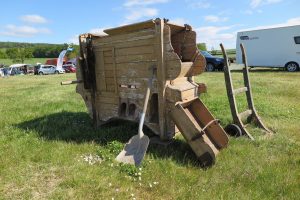 In this county there are a few threshing mills that are put in motion by water; and wherever this element can be applied they answer well. There are none driven by steam; though steam engines have everything to recommend the, for the purpose, by the expense. Neither are there any that are driven by the wind. Mills of this description might be cheaper in point of cost; but the uncertainty of going, to which they would be liable, is a great drawback attending them. The greater number are drawn by four or more horses or oxen in each; and of course are upon a scale of expense of from £140 to £150. Thus the use of threshing machines, though extending yearly, has not yet descnded to the moderate means and necessities of the inferior order of farmers, the most numerous class in the shire.
In this county there are a few threshing mills that are put in motion by water; and wherever this element can be applied they answer well. There are none driven by steam; though steam engines have everything to recommend the, for the purpose, by the expense. Neither are there any that are driven by the wind. Mills of this description might be cheaper in point of cost; but the uncertainty of going, to which they would be liable, is a great drawback attending them. The greater number are drawn by four or more horses or oxen in each; and of course are upon a scale of expense of from £140 to £150. Thus the use of threshing machines, though extending yearly, has not yet descnded to the moderate means and necessities of the inferior order of farmers, the most numerous class in the shire.
It may be remarked before quitting this subject of implements, that Fanners for cleansing corn have been long used in this county. They now cost about £4, and where threshing machines are used, they are very generally attached to them.
The photographs of implements were taken at the Scottish National Tractor Show, September 2014.
